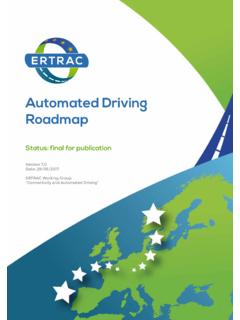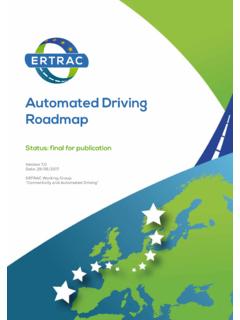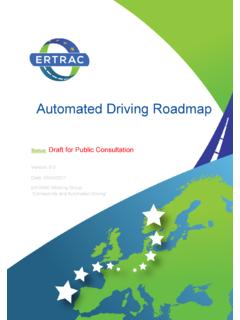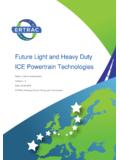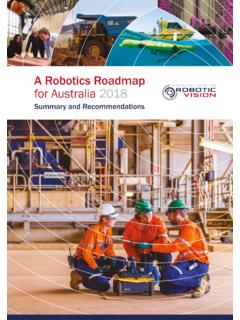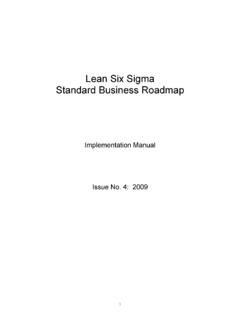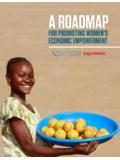Transcription of Integrated Urban Mobility Roadmap - Ertrac - …
1 Integrated Urban Mobility Roadmap Adopted: December 2016. Published: February 2017. Author/ Ertrac Working Group: Joint Ertrac -ERRAC-ALICE Working Group on Urban Mobility Integrated Urban Mobility Roadmap TABLE OF CONTENTS. Table of contents 2. 0. Executive Summary 4. 1. Introduction 5. Background 5. Scope 6. Complementarity between Ertrac roadmaps 6. Policy Background and High-Level Targets 7. The city of today and tomorrow 9. 2. Research needs, priorities and milestones 12. Changing societal trends new Urban Mobility scenarios 12. Decarbonisation and air quality 12. City dynamics 13. Demographic challenges 16.
2 Digital society 17. Sharing economy solutions 20. Impact of introducing automation services in a multimodal scenario 23. MILESTONES 25. Frameworks/Enablers 27. SUMPs 28. Big data and modelling tools for better services and policy making 29. Governance, regulation and business models 34. Transferability, Capacity building and Upscaling 36. MILESTONES 38. 2. Innovative Urban Mobility solutions and services 40. A. Infrastructure related solutions 41. Land use and transport interactions 41. Smart Interchanges 43. Optimised use of infrastructures 46. MILESTONES 48. B. Management related solutions 49.
3 Demand management 49. Integrated Urban Mobility and network management 51. Integrating Urban Mobility within overall European transport chains 53. MILESTONES 55. C. Service related solutions 56. Integrated information 56. Integrated payment 59. Urban freight and logistics 61. MILESTONES 64. D. Modal solutions 66. Clean fuels and vehicles 66. Active and light travel modes 69. MILESTONES 71. 3. Table of figures 72. 4. References 73. 5. Members of the working group 74. This document has been published with the support of FOSTER-ROAD, funded by the 7th Framework Programme of the European Union. 3. Integrated Urban Mobility Roadmap 0.
4 EXECUTIVE SUMMARY. This report presents a research Roadmap paving the way towards an Integrated Urban Mobility system, delivered by the joint Urban Mobility Working Group of Ertrac , the European Road Transport Research Advisory Council, ERRAC, the European Rail Research Advisory Council, and ALICE, the Alliance for Logistics Innovation. Urban Mobility is vital to European society in providing access to services for passengers and goods and supporting economic growth. European cities are facing similar challenges, such as congestion and pollution, and perceiving similar trends, such as digitalisation, the sharing economy, etc.
5 At the same time, transport demand continues to increase. To manage this increasing demand as well as tackle the related societal challenges, a wide range of complementary Mobility solutions and services adopting innovative user-centric, smart, multimodal and intermodal approaches, is required. This Roadmap identifies research priorities related to Urban Mobility and freight delivery with the aim to achieve a more convenient, competitive, sustainable and resource-efficient Mobility system, which is essential to secure a high level of accessibility for passengers and goods as well as economic growth.
6 The Roadmap updates, integrates and complements previous roadmaps and reference documents produced by the Ertrac -ERRAC Urban Mobility Working Group, 1) Towards the integration of the Urban Mobility system, the joint Ertrac / ERRAC Roadmap of 2011, 2) Urban freight Roadmap , jointly developed between Ertrac and ALICE in 2014, 3) Land Use and Transport Interaction (2013) and 4) Road User Behaviour and Expectations (2011). All modes of transport and all types of users, vehicles, infrastructures and services are addressed and an overview is provided of Mobility services and solutions that offer significant potential to contribute to decarbonisation in view of the European 2050 target.
7 The proposed research actions involve three aspects: a better understanding of current and emerging societal trends and challenges; creating or improving frameworks/enablers that remove barriers and/or enhance a more efficient Mobility provision and more effective transport policy implementation; and finally identifying innovative Urban Mobility solutions and services to tackle Mobility challenges at short, medium and long term and this from an infrastructure, management, services and modes perspective. A distinction is made between RTD, demonstration, deployment/. market introduction and policy development.
8 This Roadmap addresses the main stakeholders of the sector (cities, industry, retail, logistics service providers), and aims to contribute to the definition of research priorities for European research and innovation programmes, including Horizon 2020, the European Framework Programme for Research and Innovation for 2016-2020, and subsequent European Framework Programmes. 4. 1. INTRODUCTION. Background Ertrac , the European Road Transport Research Advisory Council, represents the diverse range of road transport stakeholders and brings them together with representatives from public authorities at the European, national, regional and Urban levels.
9 The multi-stakeholder nature of Ertrac makes it unique in being able to present a holistic and Integrated view of road transport issues. Ertrac 's mission is to seize the opportunity for better coordination of private and public research activities, and to make specific recommendations for their implementation. Ertrac . delivers roadmaps for cross-cutting research that provide a reference for the future planning of European and national transport programmes. In addition, it is hoped that this reference provides an overarching framework for research, innovation and technological development, as well as guidance for individual research planning.
10 For the particular case of the Urban Mobility Working Group, the multi-stakeholder dimension is even more explicit. Given the Integrated and essential multimodal nature of the Urban transport system, it was decided to adopt a collaborative approach and join forces with the European Technology Platforms ERRAC (rail) and ALICE (freight) for a joint cross-ETP Working Group on Urban Mobility . Today's and tomorrow's Urban Mobility system - encompassing all modes of transport - is facing new societal challenges and economic patterns. In order to be able to achieve a more convenient, competitive, sustainable and resource-efficient Mobility system as well as guarantee a high level of accessibility for passengers and goods, time had come to produce an updated and Integrated Ertrac Urban Mobility Roadmap that identifies the research and innovation needs that have to be addressed to meet these new challenges and trends.
